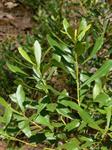| Family | Scientific Name | Common Name | Habitat | Distribution | Image |
|---|---|---|---|---|---|
| Myricaceae | Morella caroliniensis | Pocosin Bayberry, Evergreen Bayberry | Pocosins, wet savannas and pine flatwoods, sandhill seepage bogs, and other peaty or sandy-peaty wetlands. | Primarily limited to the Southeastern Coastal Plain, from NJ south to FL and west to TX and AR. |  |
| Myricaceae | Morella cerifera | Common Wax-myrtle, Southern Bayberry | Interdune swales (where often dominant), pocosins, brackish marshes, other wet to moist habitats, now also widely planted (including in the Piedmont) as an ornamental or landscaping shrub and persistent or naturalizing in suburban woodlands. | As a native, widespread in the Coastal Plain of Southeastern United States: NJ south to FL and west to TX; Bahamas; West Indies; Mexico and Central America. |  |
| Myricaceae | Morella inodora | Odorless Bayberry | Acid wetlands, especially in wooded, acid, streamhead "bogs" and bayheads, often associated with Magnolia virginiana, Tamala palustris, Cyrilla racemiflora, Cliftonia monophylla, and Lorinseria areolata. | A Southeastern Coastal Plain endemic: se. GA west to s. MS. |  |
| Myricaceae | Morella pensylvanica | Northern Bayberry | Dunes, sometimes even on the foredune and stoloniferously colonizing the upper beach, more typically behind the foredune on secondary dunes and sandy flats, often growing intermixed with Morella cerifera, but able to occupy drier sites higher on the dunes, from VA north, also ranging inland in sandy situations. | NL (Newfoundland), QC, and ON south to ne. NC (Avon or Kinnakeet, Dare County), n. OH, and s. MI. |  |
| Myricaceae | Morella pusilla | Dwarf Bayberry, Dwarf Wax-myrtle | Pine savannas, pine flatwoods, relatively moist to extremely dry sites in sandhills (under Quercus laevis and Q. geminata). | A Southeastern Coastal Plain endemic: se. VA south to s. FL and west to e. TX. |  |
Cite as...